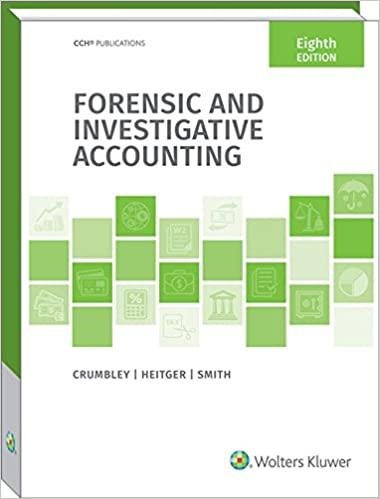Question
Q1) Which of the following notes payable uses the blended payment method? Select one: a. A $160,000 note payable that requires quarterly repayment of $10,000
Q1) Which of the following notes payable uses the blended payment method?
Select one:
a. A $160,000 note payable that requires quarterly repayment of $10,000 principal plus interest on the remaining principal, thus quarterly payments steadily decrease over time to reflect the fixed quarterly reduction in principal
b. A $100,000 note payable that requires equal monthly payments of $5,500 that include both principal and interest
c. None of the available choices
d. A $500,000 note payable that requires monthly interest payment of $2,083 and repayment of $500,000 principal at maturity
Q2) Private investors usually buy bonds:
Select one:
a. From their insurance companies
b. On the securities exchange market after being issued by a company
c. Directly from the company
d. From their banks
Q3) The balance of the Premium on Bonds:
Select one:
a. Is written off immediately when the bonds are sold
b. Remains unchanged until the bonds are redeemed
c. Increases over the life of the bonds
d. Diminishes over the life of the bonds
Q4) The issuing company received $100,000 in cash for bonds with a face value of $100,000. The bonds were issued at:
Select one:
a. A premium
b. A bargain price
c. Par
d. A discount
Q5) Which of the following statement(s) is are correct regarding presentation of interest expense from the bonds payable on the income statement?
Select one:
a. When the bonds are issued at a premium, thee income statement reports interest expense for the period equal to the bonds contractual interest rate minus the amortized portion of the premium.
b. All of the available choices.
c. When bonds are issued at par, the income statement reports interest expense for the period equal to the bonds contractual interest rate.
d. When the bonds are issued at a discount, the income statement reports interest expense for the period equal to the bonds contractual interest rate plus the amortized portion of the discount.
Q6) Compound interest:
Select one:
a. Is the same as simple interest
b. Unrelated to the time value of money
c. Occurs when interest is earned on interest
d. None of the available choices
Q7) The Discount on Bonds account is a/an:
Select one:
a. Liability
b. Asset
c. Contra-asset
d. Contra-liability
Q8) Interest paid on a bond is classified as a/an:
Select one:
a. Other expense
b. Revenue
c. Operating expense
d. Cost of goods sold
Q9) Annuities are:
Select one:
a. Periodic and recurring fixed payments
b. Periodic and recurring payments that are variable based on fluctuations in market interest rate
c. Periodic and recurring payments that systematically decrease throughout the life of the bonds
d. Principal repayments
Step by Step Solution
There are 3 Steps involved in it
Step: 1

Get Instant Access to Expert-Tailored Solutions
See step-by-step solutions with expert insights and AI powered tools for academic success
Step: 2

Step: 3

Ace Your Homework with AI
Get the answers you need in no time with our AI-driven, step-by-step assistance
Get Started


